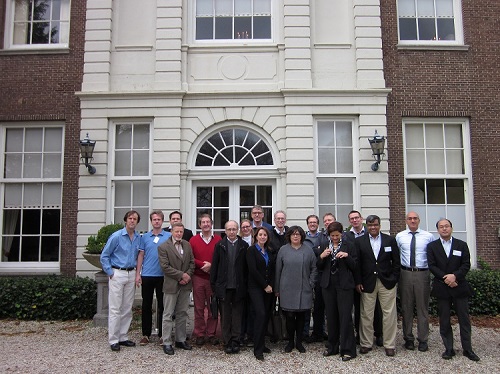VCP-related multi-system proteinopathy
- Number 215
- Date 27 November 2015
Location: Heemskerk, The Netherlands
Description:
Organizers:Teresinha Evangelista (UK); Virginia Kimonis (USA); Hanns Lochmüller (UK); Conrad Weihl (USA); Michael Hanna (UK)
Attendees: Workshop attendees included a multidisciplinary group of 19 participants from 6 countries comprising both basic and clinical researchers and two patient representatives.
VCP is an essential enzyme which regulates cell cycle, organelle biogenesis, and protein degradation via different pathways. VCP mutations cause an age-related, multi-system degenerative disease which displays variable penetrance and gives rise to four dominant symptoms (phenotypes) within families: myopathy, motor neuron disease, Paget’s disease of the bone and frontotemporal dementia. Importantly and distinct to this syndrome, family members may each suffer from a different symptom of the disease.
During the workshop, the group discussed multiple aspects of the disease, such as current patient cohorts in four countries, the variability of genetic disorders related to the VCP disease and the expansion of the phenotypic spectrum to include sporadic disorders. The group also discussed the cellular and molecular aspects of VCP function and dysfunction in diseases, while reviewing the existing animal models and potential therapeutic targets, including VCP-specific therapies. In addition, the group considered patient diagnosis within rheumatology, neuromuscular and dementia clinics and the current clinical management of the three key phenotypes: myopathy, Paget’s disease and dementia. Examples of patient registries, natural history studies and clinical trials in rare neuromuscular diseases also formed part of the discussion.
However, some questions still remain unanswered in regard to VCP disease and a number of areas require further research:
- Incomplete understanding of the molecular and cellular consequences of VCP disease mutations.
- Lack of consensus on the utilization of animal models for pre-clinical studies.
- Correlation between phenotypes and genotypes, disease modifiers and prognostic biomarkers is still unclear.
- Lack of clinical trial readiness due to unclear patient outcomes, natural history and active patient registry.
- Unclear true prevalence in different populations (muscle, rheumatology, dementia clinics).
- Lack of current knowledge regarding dietary and exercise regimes for this group of patients.
What were the outcomes of the workshop and how will they benefit patients?
- Development of VCP-related clinical research projects based on collaboration between rheumatologists, cognitive neurologists, neuromuscular specialists and a research consortium with the aim of exchanging clinical results and research resources.
- Improved understanding of the VCP disease’s phenotypes and how to standardize clinical care through the multi-disciplinary clinical management of various specialists.
- 10 additional mutations that cause the VCP disease were reported, expanding the number to 50.
- Exchange of pre-clinical data from promising therapies applied in mouse models.
- Open consortium to include other clinical groups with VCP patients
Future plans for the VCP disease consortium include:
- Development of a VCP disease global registry and the systematic collection of DNA, patient biomaterial and clinical imaging data into biobanks and other suitable infrastructures that allow controlled access for the wider research community.
- Development of an information sheet to inform patients about how patient material and the clinical information of those with VCP disease phenocopies are shared.
- Drafting of guidelines for clinical care and clinical research phenotyping of VCP patients.
- Update the census of existing, available clinical material (Coriell /EuroBioBank).
- Update the Leiden Database with existing mutations.
- Census of available VCP patients from the consortium.
- Form a working group to focus on clinical trial outcome measures, natural history and study design with the intent of preparing for future clinical trials.
- Engage existing patient advocacy groups by providing workshop reports to MDA, ALS, FTD, Paget’s and myositis associations.
- Patient initiated social media site on the VCP disease.
A full report is published in Neuromuscular Disorders (pdf).

